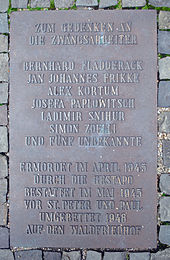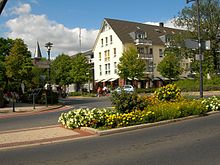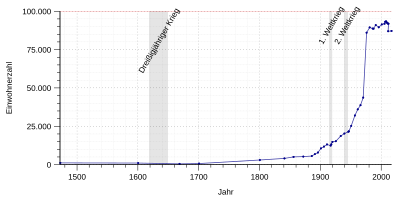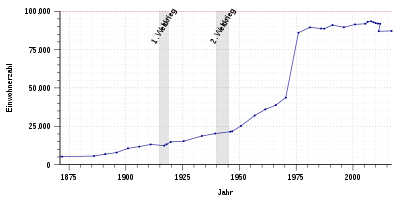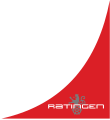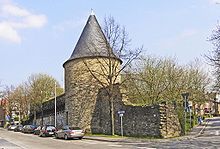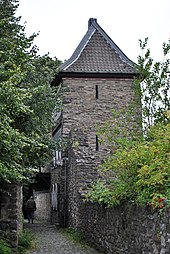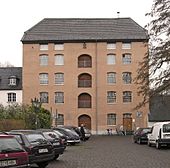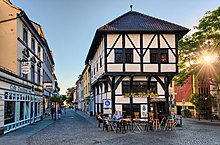Ratingen
| coat of arms | Germany map | |
|---|---|---|
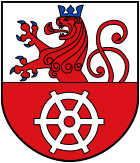
|
Coordinates: 51 ° 18 ' N , 6 ° 51' E |
|
| Basic data | ||
| State : | North Rhine-Westphalia | |
| Administrative region : | Dusseldorf | |
| Circle : | Mettmann | |
| Height : | 50 m above sea level NHN | |
| Area : | 88.74 km 2 | |
| Residents: | 87,520 (Dec. 31, 2019) | |
| Population density : | 986 inhabitants per km 2 | |
| Postcodes : | 40878-40885 | |
| Area code : | 02102 | |
| License plate : | ME | |
| Community key : | 05 1 58 028 | |
| LOCODE : | DE RAT | |
| City structure: | 6 municipal districts with 10 districts | |
City administration address : |
Minoritenstrasse 2-6 40878 Ratingen |
|
| Website : | ||
| Mayor : | Klaus Konrad Pesch ( independent ) | |
| Location of the city of Ratingen in the Mettmann district | ||
The city of Ratingen located in the state of North Rhine-Westphalia and is a large district town of the district of Mettmann in the administrative district of Dusseldorf and centrally located in the Rhine-Ruhr . According to internal community updates, Ratingen is the largest city in the Mettmann district with around 92,487 inhabitants (as of December 31, 2017).
geography
Geographical location
Ratingen is located in the northwestern foothills of the Bergisch land on one of the Rhine - terraces at an altitude 55 and interlocutory 180 m above sea level. NN ; the city center is around 70 m above sea level. NN .
Ratingen borders in the south and west on the state capital Düsseldorf , in the north on the cities of Duisburg , Mülheim an der Ruhr and Essen and in the east on the cities of Heiligenhaus , Wülfrath and the district town of Mettmann .
The Anger flows north of the center of Ratingen and the Schwarzbach in the south . There are several nature reserves in Ratingen , including the Hinkesforst natural forest cell .
climate
The annual precipitation is 820 mm and is therefore rather high, as it falls in the upper third of the values recorded in Germany: Lower values are recorded at 67% of the measuring stations of the German Weather Service . The driest month is February, the most precipitation falls in June (1.7 times as much as in February). The precipitation varies moderately: At 39% of the measuring stations lower seasonal fluctuations are registered.
City structure
Ratingen is the most populous city in the Mettmann district. There are six municipal districts according to the municipal code:
| district | district | Inhabitants 12/2016 |
Post Code |
|---|---|---|---|
| Ratingen center | center | 23,822 |
40878
|
| east | 8,554 |
40882
|
|
| west | west | 17,808 |
40880
|
| Tiefenbroich | Tiefenbroich | 6,594 |
40880
|
| Lintorf / Breitscheid | Lintorf | 15,267 |
40885
|
| Breitscheid | 5,202 |
40885
|
|
| Hösel / Eggerscheidt | Hösel | 8,368 |
40883
|
| Eggerscheidt | 964 |
40883
|
|
| Homberg / Schwarzbach | Homberg | 5,310 |
40882
|
| Schwarzbach | 473 |
40882
|
history
Early history and antiquity
The beginning of the first settlement of the urban area can no longer be precisely determined. Finds of about 150,000 years old hand axes and other anthropogenic objects near today's Silbersee prove that people lived there as early as the beginning of the last Ice Age . However, it is not clear whether these people were already permanent residents.
However, grave finds in the center of Ratingen suggest that it was around 500 BC. There was already a permanent settlement. The spur of this area on a flat hill between two streams was very favorable for the needs of the time; In addition, it was at the crossroads between the Mauspfad , an ancient trade route between Cologne and the Lower Rhine , and the Heiligenweg, a connection between the Rhine and Bergisches Land. The Hilinciweg also ran through the Ratingen area.
middle Ages
Around 500 AD Ratingen became a battle zone between Saxony and Franconia .
The settlement was first mentioned in a document before 849 in the Werden Chartular , where Ratingen is referred to as "Hratuga". There are two explanations for the name: It could mean clearing in the forest or a "settlement of the Hratan".
Since the Middle Ages , the Ratingen area has belonged to the counts, later dukes, of Berg . For them, the settlement, which was initially protected by wooden palisades, played an important role in the fight against the Archbishop of Cologne . Probably because of its advantageous strategic position Ratingen was founded on 11 December 1276 by Count Adolf V. von Berg , the city rights awarded. Eleven months earlier, the Archbishop of Cologne, Siegfried von Westerburg , had acquired the city and castle of Kaiserswerth . Count Adolf V wanted to create a counterweight through the town elevation of Ratingen and secure the northern Bergische area by granting and fortifying the old church and court location, located at the intersection of important roads.
In return for the associated privileges such as duty and tax exemption and monopolies on the grinding of grain and the production of Grüt , a material required for beer production at the time ( Grütrecht ), the city built the mighty city wall with large defense towers and up to 8 m wide moats.
In the further course of history, Ratingen experienced an economic boom as one of the four main towns in Berg. Ratingen had market law , guild law , its own mint and a court that was superordinate to the courts in Mettmann , Gerresheim and Düsseldorf due to the older city law in the consultations. Charles IV visited the city on November 25, 1377, followed by Christian I of Denmark about 100 years later .
The guild of blacksmiths and grinders , which was mentioned in the city register in 1362 , probably had the most important supra-regional economic importance . They used the water from Anger and Schwarzbach to make weapons, tools (especially knives and scissors) and other everyday objects such as musical instruments. Their goods were also traded abroad, including in Antwerp , the Baltic States and Scandinavia . In 1592 Jews were first mentioned in a document in Ratingen.
Industrialization and modern times
Ratingen's economic boom that had lasted for centuries ended in the 16th century: nearby Düsseldorf became a residence in 1511 , and later a state fortress. The plague came over the city, new weapons made the city wall ineffective, and in 1641 it was completely destroyed during the Thirty Years War after the castle Haus zum Haus was occupied by the imperial Melchior von Hatzfeld , who attacked the city and built houses around the city Set fire. At that time only 140 people lived in Ratingen; 200 years earlier it was over 1,000.
But it is precisely in this little town, which at that time had become almost insignificant, that the beginning of continental European industrialization is seen today : The Elberfeld businessman Johann Gottfried Brügelmann built a mechanical cotton spinning mill on the Anger in 1783 , which is considered the first factory on the European mainland. Due to its technical and historical importance, the former Cromford textile factory is now operated by the Rheinisches Industriemuseum as a textile museum .
The town's post office, which was set up in the 18th century, was also an expression of the town, which was slowly growing again economically . This was set up by the Ratingen magistrate on June 19, 1727 at the latest. The Stadtpost connected the Bergisch city of Ratingen with Düsseldorf and ensured the connection to the Imperial Post Office operated by the Thurn und Taxis and thus to the world of trade and communication.
After the Congress of Vienna and the takeover of the city by Prussia was until 1816 a postal station of the Thurn-und-Taxis Post before this to July 1, 1816 Prussian Post Office warden was. As a result of the Congress of Vienna, Ratingen belonged to Prussia, the administrative district of Düsseldorf and the province of Jülich-Kleve-Berg (seat in Cologne) from 1815, and from 1822 to the Rhine province with seat in Koblenz . In 1817 the Ratingen Jews built a synagogue on Bechemer Strasse.
Due to the occurrence of molding sand , an iron industry emerged from the middle of the 19th century . Other industrial companies also emerged, such as a paper mill in Angertal, roof pan distilleries and several lime distilleries . But the economy only gained momentum with the almost simultaneous construction of two railway lines, the Ruhr Valley Railway in the east (today the S 6 line ), which began operating on February 1, 1872, and the "Westbahn" (part of the railway line ), which was completed in 1873 Troisdorf – Mülheim-Speldorf ), a competing connection from Düsseldorf to Mülheim and Duisburg. On May 28, 1903, the Angertalbahn (today mostly called "Kalkbahn") was inaugurated, via which lime and molding sand, and until the 1950s also people, were transported from Wülfrath and the local lime works to the Westbahn and still are today.
Due to the now established transport links, numerous small and medium-sized companies settled in the area around the railways: in 1883 the steam boiler manufacturer Dürr , in 1910 the Deutsche Lastautomobilfabrik AG (DAAG). In the municipal reorganization of 1929 Ratingen maintained its independence. The municipality of Eckamp with today's districts of Tiefenbroich and Ratingen-West was incorporated in 1930.
After coming to power of the Nazis in 1933 city government, culture and society were brought into line . Social democratic or communist functionaries like Josef Schappe were arrested and placed in “protective custody”, while Jewish citizens were harassed or forced to emigrate. On the night of November 10, 1938 , the Jewish cemetery on Werdener Strasse was desecrated and devastated. From the summer of 1943 the state police headquarters in Düsseldorf ( Gestapo ) was housed in Ratingen (teachers' seminar at Mülheimer Straße 47, today: City Archives and Anne Frank School), as it was bombed out in Düsseldorf. Political prisoners, slave laborers and opponents of the regime were interrogated and tortured here. The Second World War , which had called for several heavy air raids, such as on March 22, 1945, on Ratingen, ended with the collapse of the Ruhr basin on 16/17. April 1945, marked by the suicide of the Ruhrkessel commander Walter Model in the forest near Ratingen-Lintorf south of Duisburg. On April 17, 1945, the city, which was under artillery fire, was handed over to tank commander Major W. Ashley Gray in the evening without a fight, without counter-actions by the werewolf or the Volkssturm .
During the last days of the war, the Gestapo carried out final phase crimes in Ratingen (Kalkumer Wald). The 11 forced laborers who were shot at the time and buried in the Kalkum Forest were dug up by the Nazis on the instructions of the Americans in May 1945 and then solemnly buried in front of the parish church of St. Peter and Paul, with the Nazis having to perform auxiliary services. Ratingen's first post-war mayor, Dr. Franz Josef Gemmert, director of the Brügelmann cotton spinning mill . On June 9, 1948, these dead were reburied in a grave in the Ratinger Waldfriedhof for final rest. A plexiglass plaque reminds of them with the following text: “Here are eleven forced laborers who were recovered from a bomb crater in the Kalkum Forest on May 13, 1945 by order of the military government and buried in front of the church of St. Peter and Paul. They were murdered by the Gestapo shortly before the end of the war. On June 9, 1948, with the consent of the military government, the dead were reburied in this grave for eternal rest. On the basis of research, the names of six people could be determined: Bernhard Fladerrack, Jan Johannes Frikke and Simon Zoelli from the Netherlands, Alex Kortum from Russia, Ladimir Snihur from Poland and Josefa Paplowitsch from Ukraine. Many of the other dead buried there were also slave laborers. They perished from exhaustion, illness or as a result of acts of war. "
After relatively minor war damage, Ratingen saw the development of a dormitory city in the 1960s and 1970s (such as the Ratingen-West district, which emerged in the late 1960s with 20,000 inhabitants in 1980) and the location of service and small businesses for nearby Düsseldorf. In 1973 the population of 50,000 was exceeded even before further incorporations.
However, since the 1970s, the successful economic policy and the favorable infrastructure conditions have contributed to the fact that Ratingen has lost its character of a dormitory city again and has turned into the opposite: For some years now, Ratingen has had a clearly positive commuter balance despite the three immediately adjacent regional centers ( see section: Economy ).
Municipal reorganization
In the course of the local reorganization on January 1, 1975, both the old town of Ratingen and the previously independent communities Breitscheid , Eggerscheidt , Hösel and Lintorf (all part of the former Angerland office ) and Homberg-Meiersberg (part of the former Hubbelrath office) were dissolved and with the inclusion of the Schwarzbachtal in the dissolved community of Hasselbeck-Schwarzbach (belonging to the former Hubbelrath office), merged to form a new city of Ratingen.
Population development
In the Middle Ages and at the beginning of the modern era , Ratingen was a place with a few hundred inhabitants. The population grew only very slowly and fell again and again due to the numerous wars, epidemics and famine. It was only with the establishment of the Cromford textile factory in 1783 and especially the beginning of industrialization in the mid-19th century that the city began to grow more rapidly. In 1855 only 5,000 people lived in Ratingen, by 1950 there were already 25,000. By 1973 that number had doubled to 52,216.
On January 1, 1975, the population increased through the incorporation of several places - including Lintorf (10,593 inhabitants 1970) - to around 85,000. On June 30, 2005, the " official population " for Ratingen was 91,865 according to updates by the State Office for Data Processing and Statistics North Rhine-Westphalia (only main residences and after comparison with the other state offices).
The following overview shows the number of inhabitants according to the respective territorial status. Up to 1800 these are mostly estimates, then census results (¹) or official updates from the State Statistical Office. From 1871, the information relates to the “local population”, from 1925 to the resident population and since 1987 to the “population at the location of the main residence”. Before 1871, the number of inhabitants was determined according to inconsistent survey procedures.
|
|
|
¹ Census result
² According to the population register
³ According to the 2011 census
⁴ State Office for Information and Technology North Rhine-Westphalia (IT.NRW)
Coat of arms, flag and logo
The city of Ratingen was last awarded a coat of arms, a seal and a flag on October 3, 1972. The coat of arms was redesigned by the Aachen graphic artist Walther Bergmann based on the 1909 coat of arms.
coat of arms
Blazon : “Divided into silver (white) and red; above a growing two-tailed, blue crowned and armored, red lion and below a silver (white) six-spoke wheel. "
The coat of arms shows the Bergische Löwen and a straightening wheel, which indicates a former court. It comes from a seal from 1430. It was approved for the first time on December 30, 1909 by the Prussian Minister of the Interior, but with a five-spoke wheel and a wall crown that was customary at the time .
flag
"The flag has three stripes in a ratio of 1: 3: 1 from red to white to red and shows the city coat of arms in the shield in the middle of the white line."
politics
City council
|
|
||||||||||||||||||||||||||||||||||||||||||||||||||
The local elections on May 25, 2014 resulted in the following distribution of seats in the city council:
| Political party | Voting share | Council seats |
|---|---|---|
| CDU | 34.6% | 20th |
| Citizens Union | 24.3% | 14th |
| SPD | 20.9% | 12 |
| Green | 9.6% | 5 |
| FDP | 4.6% | 3 |
| AfD | 3.1% | 2 |
| Pirates | 2.9% | 2 |
| Turnout: 51.6% | ||
mayor
For the mayors from 1320 to 1806 (the time when Ratingen was a “capital” in the Duchy of Berg ) see the list of mayors of Ratingen 1320–1806 .
In the mayoral election in 2014, Klaus Konrad Pesch, who was jointly supported by the CDU, SPD, FDP and the Greens, was elected as the new mayor.
Mayor since the city was reorganized through municipal reorganization in 1975 (voluntary until 1999):
- 1975–1989: Ernst Dietrich (CDU)
- 1989–1994: Hugo Schlimm (SPD)
- 1994-2004: Wolfgang Diedrich (CDU)
- 2004–2014: Harald Birkenkamp (Citizens' Union)
- since 2014: Klaus Konrad Pesch (independent)
Youth Council
Since 1998 a youth council has been elected by students from secondary schools in Ratingen. It consists of up to 45 members who must be between 13 and 18 years old. The youth council was newly elected in November 2019 and the term of office is 2 years. The speakers are currently Claus Köster and Vivienne Wendeler.
Town twinning
Ratingen maintains partnerships with the following municipalities:
-
 Maubeuge , France (since 1958)
Maubeuge , France (since 1958) -
 Le Quesnoy , France (partnership of the old parish of Hösel, since 1963)
Le Quesnoy , France (partnership of the old parish of Hösel, since 1963) -
 Cramlington , United Kingdom (contact since 1967, 1986-2016)
Cramlington , United Kingdom (contact since 1967, 1986-2016) -
 Vermillion , South Dakota , USA (since 1969)
Vermillion , South Dakota , USA (since 1969) -
 Kokkola , Finland (since 1989)
Kokkola , Finland (since 1989) -
 Beelitz , Brandenburg , Germany (since 1990)
Beelitz , Brandenburg , Germany (since 1990) -
 Gagarin , Russia (since 1998)
Gagarin , Russia (since 1998) -
 Wuxi , Jiangsu Province , People's Republic of China (since 2007)
Wuxi , Jiangsu Province , People's Republic of China (since 2007)
schools
Elementary schools
- Albert Schweitzer School
- Anne Frank School
- Astrid Lindgren School
- Christian Morgenstern School
- Eduard Dietrich School
- Erich Kästner School
- Brothers Grimm School
- Heinrich Schmitz School
- Johann Peter Melchior School
- Karl Arnold School
- Ludgerus School
- Matthias Claudius School
- Minorite School
- Paul Maar School
- Suitbertus School
- Wilhelm Busch School
Further training
- Adam Josef Cüppers Vocational College
- Carl Friedrich von Weizsäcker-Gymnasium (formerly Theodor-Heuss-Schule / Geschwister-Scholl-Schule)
- Dietrich Bonhoeffer High School
- Elsa Brandström School (secondary school), dissolved in 2015
- Friedrich-Ebert-Realschule
- Käthe Kollwitz School (Realschule)
- Copernicus High School
- Liebfrauenschule (secondary school, only girls until 2013/2014)
- Martin Luther King Comprehensive School
- Werner Heisenberg Secondary School
Other schools
- Comenius School (special needs school)
- Franz-Rath-Weiterbildungskolleg (evening secondary school), dissolved in 2017
- Helen Keller School (special needs school)
- Private special school II
- Ratingen Adult Education Center
Culture and sights
Buildings
Marketplace
The center of Ratingen is the marketplace, on which goods have been offered for at least 1371. The weekly market now takes place there every Tuesday, Thursday and Saturday. The market square is determined by the town house (built around 1300) and the church of St. Peter and Paul behind it (see below). The Minorite Monastery (built in 1656) is somewhat hidden to the northwest of the market square .
city wall
From the city wall with its formerly 15 watchtowers , only parts with a total of three towers have survived:
- To the north of the center between Turmstrasse and Angerstrasse, in addition to the city wall, there is also the reconstructed city moat and the Dicke Turm ⊙ , a 13 meter high and almost 12 meter wide defense tower with a wall thickness of 3.5 meters, first mentioned in 1464, 2008 by one Heimatverein converted into a clubhouse.
- The Trinsenturm ⊙ , built in 1474 and used as an armory, is located to the west of the center by the town hall on the city wall .
- To the east of the center is a small piece of the city wall on Wallstrasse with the Kornsturm ⊙ from 1460.
Churches
The most famous church in Ratingen is St. Peter and Paul . The foundations of the early Gothic building date from the 8th century. The two east towers were built in the 11th or 12th century. The main nave essentially dates from the year 1300. Inside the church, the three bells and the monstrance tower are particularly worth seeing. Sculptures of the baroque interior are now in the Ratingen Museum .
The Evangelical City Church (completed in 1684) is one of the oldest surviving former Evangelical Reformed churches in the Rhineland .
Wasserburg house to house
Already in the 9th century there was a hill fort protected by palisades at the site of today's moated castle Haus zum Haus . She had a decisive influence on the development of the city of Ratingen. Today the castle houses a cultural center, a restaurant, residential buildings and an architecture office.
Landsberg Castle
Landsberg Castle is located in Ratingen-Breitscheid, a castle built in the 13th century for Adolf V. von Berg at the foot of the Ruhr Valley . The castle now houses a conference center for Thyssen-Krupp AG ; However, it can be viewed from the outside from the surrounding publicly accessible park.
Linnep Castle
Linnep Castle is located in Ratingen-Breitscheid together with the Linnep Forest Church. The castle is privately owned and can only be viewed from the outside, except for occasional events.
Graefgenstein Castle
The castle Gräfgenstein ⊙ , also called Griffgenstein, is preserved in parts of medieval castle and a monument in North Rhine-Westphalia. The castle is privately inhabited, used as a farm and can only be viewed from the outside.
House Anger
Haus Anger is a former manor in the Angertal nature reserve , surrounded by Angermühle and Angerforsthaus.
Cromford
Johann Gottfried Brügelmann built the Cromford textile factory ⊙ in 1783 , which is considered the first factory on the European continent. He named it after the central English town of Cromford , from which he obtained the construction principles of a spinning machine ( waterframe ) used there by means of industrial espionage .
The lavishly restored factory building is now part of the decentralized Rheinisches Industriemuseum . By means of functional replicas, you can see the spinning mill in operation there. In front of the factory is the spacious mansion with additional exhibition areas.
The Baroque gardens opposite the manor house lead to the Poensgenpark ⊙ (also: Cromford Park), laid out in 1890, with spacious lawns and many exotic trees and bushes from all over the world. It was included as an excellent park in 2004/2005 in the street of garden art between the Rhine and Maas .
In the Red Rooster
The half-timbered house (also called Wallersches Haus or Suitbertus-Haus ) in Oberstraße 23, which dates from the 15th century, is considered to be the most beautiful and oldest half-timbered house in Ratingen. It owes its current existence to a fire wall in the west, which spared it from the extensive destruction of Ratingen in 1641. Today it houses an inn.
Auermühle
The Auermühle ⊙ is the successor to a water mill on the Anger from around 1700.
Parks
In addition to the Poensgenpark mentioned above , Ratingen has extensive forest areas as well as the 110 hectare Volkardey recreation park with the reconstructed Iron Age farmstead , which includes the Green Lake and the Silver Lake (see also Ratingen-West ), as well as the Blue Lake with a small amusement park and open-air Theatre. Ironically, the water of the Blue Lake is green and that of the Green Lake is blue.
An art path leads from the natural meadows of the Angertal, through the historic Poensgenpark around the former Cromford textile factory to the above-mentioned. Recreation area at the Green Lake .
Further information about the parks and forest areas mentioned above can be found in the leisure tips of the city of Ratingen .
Dumeklemmer
Ratingen is often called Dumeklemmerstadt as and its inhabitants Dumeklemmer ( High German : Daum Klemmer ), respectively. The origin of this name is often ascribed to the so-called Dumeklemmersage : According to this legend , the missionary Suitbertus wanted to convert the then pagan city of Ratingen to Christianity . However, when he wanted to pass the city gate , the Ratinger slammed him in front of the nose; the Suitbert's thumb was caught in the door. Suitbert is said to have turned his back on the city without having achieved anything, but previously cursed its residents , according to which in future all those born in Ratingen should be born with a flat thumb. Since then, the Ratinger is said to have been nicknamed "Dumeklemmer".
Historians think little of this legend, however, especially because Suitbert lived over 500 years before the city charter was granted in 1276 and the city gate was built.
The more likely cause is therefore the fact that Ratingen was the seat of jurisdiction of the Bergisches Land for centuries in the Middle Ages . For a long time there, torture was a popular instrument for "establishing the truth" - often with the use of thumb screws . Therefore, the Ratinger in the surrounding area were called "Dumeklemmer". Today the “Dumeklemmer Fountain” in front of the Church of St. Peter and Paul commemorates the legend that shows three children with flat thumbs.
The Ratinger Dumeklemmerspektakel takes place annually in July , at which, in addition to a medieval market, the Dumeklemmersage is performed as a medieval play.
The Ratinger specialty is also known as "Dumeklemmer": thumb-sized, spicy sausages with spicy meat .
Culture
Ratingen has a city museum (the Museum Ratingen ), a city theater , a city hall ("Dumeklemmerhalle"), the large hall of which can hold up to 1030 seats, a small, often award-winning cinema and an intense club life (especially sports, Carnival, rifle and homeland clubs).
Ratingen-Hösel is the seat of the Haus Oberschlesien Foundation . It maintains the house of the same name as a cultural and meeting place as well as the Upper Silesian State Museum , a central German institution for the care and presentation of the culture and history of Silesia . In cooperation with the Eichendorff Society , the life and work of the important writer Joseph von Eichendorff is presented with numerous exhibits. The Oberschlesisches Landesmuseum has had a modern functional building on Bahnhofstrasse (B 227) since 1998. Special exhibitions take place continuously, also in Poland . The development and stimulation of cross-border contacts is an important future-oriented concern of the Haus Oberschlesien Foundation . In the Upper Silesian House, the Oberschlesier regional team also has the federal office and the state office of North Rhine-Westphalia .
Buddhism
A few years ago, the Thai community founded the Thai temple Wat Buddhasamakkee Düsseldorf on Sohlstättenstrasse 58A.
Judaism
The Jüdischer Kulturverein Ratingen e. V. SCHALOM , on whose website the history and tradition of the Jews in Ratingen is presented. In 1817/18 the Ratingen Jews bought a piece of land on Bechemer Strasse and built their own synagogue there. The use of the synagogue as a place of worship ended in 1930/1931 when the community (branch community of the Düsseldorf synagogue community ) had become too small. The building was bought by the city of Ratingen in 1936 and demolished in 1940.
Regular events
- Whitsun: Culture and cabaret festival ZeltZeit at the Green Lake
- June or July: All-around meeting in Ratingen (internationally important decathlon and heptathlon competition)
- July: Open-air event RatingenFestival in downtown Ratingen
- Summer: Folk Festival Folkerdey at the Green Lake
Economy and Infrastructure
economy
Thanks to the transport links (airport, railway and motorways) and the designation of commercial areas, Ratingen has succeeded since the 1960s in overcompensating for the decline in some traditional branches of industry by setting up modern service and computer companies. Companies with headquarters or large operations in Ratingen include Asus , Balcke-Dürr , Ball Packaging Europe , Chieftec , Computacenter , Ingenico , Harry-Brot , Hewlett-Packard , Keramag , Logica CMG, Makita , Zapp AG , Mitsubishi Electric Europe B.V., Nokia , NSK , SAP , Sun Microsystems , TechniSat , TIPTEL , TOI TOI & DIXI Sanitary Systems , Vodafone and Esprit . In 2010, Coca-Cola relocated sales and marketing from Düsseldorf-Rath to Ratingen, and in 2011 DKV Euro Service relocated its headquarters to Ratingen. Esprit has its European headquarters in Ratingen.
Despite the immediate vicinity of the three regional centers of Düsseldorf, Duisburg and Essen, Ratingen has a comparatively high job density of 380 jobs per 1000 inhabitants. The commuter balance, which was still negative at the end of the 20th century, was positive from 1997, in 2005 it was clearly positive at 5400 people (15.5% of Ratingen's jobs), and continued to rise at least until 2011 (6241 people). The purchasing power per inhabitant in 2017 was 117.1% of the national average; According to a study, Ratingen had the third highest purchasing power per inhabitant of all 396 municipalities in North Rhine-Westphalia in 2014 at € 6541.
The clothing companies Esprit , s.Oliver , Benetton and Tom Tailor operate outlet stores in Ratingen , of which Esprit's outlet is by far the largest.
traffic
Ratingen's traffic connection is characterized by its location between the Ruhr area and the metropolitan areas of Düsseldorf , Cologne / Bonn and Wuppertal .
Ratingen Mitte lies in the triangle of the A 3 (Cologne - Oberhausen ), A 52 (Düsseldorf - Essen) and A 44 ( Mönchengladbach - Ratingen Ost) motorways . The federal highway 1 and the federal highway 227 also run through the city. The neighboring Düsseldorf can also be reached via several local roads.
The city is part of the Rhein-Ruhr transport association . In public transport runs to the train stations Ratingen and Hosel the S-Bahn line S6 Cologne-Leverkusen-Dusseldorf-Ratingen food. The center of Ratingen is also connected to Düsseldorf via the U72 line of the Düsseldorf Stadtbahn . It runs in Ratingen as a classic tram and was called 712 until the Düsseldorf Wehrhahn line went into operation in February 2016 . With all neighboring cities and a network of leading buses of Rheinbahn .
Of Dusseldorf airport station is located just across the western border. It is served by local trains (including RRX ) and in long- distance passenger rail services by ICE , Intercity and Thalys trains.
Düsseldorf International Airport is only a few kilometers from the city.
The city of Ratingen is on the Euroga cycle route . Numerous cycle paths also connect the districts with each other. Bicycle connections also exist to the neighboring cities of Düsseldorf , Duisburg , Essen and Mülheim (Ruhr) . One of the oldest bicycle stations in the area of the Verkehrsverbund Rhein-Ruhr is located at the Ratingen Ost train station , housed in a completely new building since 2010 with a bicycle parking garage that is accessible 24 hours a day. The city of Ratingen is a member of the working group of pedestrian and bicycle-friendly cities, municipalities and districts in North Rhine-Westphalia (AGFS) .
Hospitals, fire brigades and rescue services
The St. Marien Hospital Ratingen is the oldest and largest hospital in the city and is run by Catholic institutions. With 204 beds and the fields of surgery, gynecology, anesthesia, internal medicine and ENT, St. Marien is a standard care hospital . In 1854 the Sisters of the Poor took over the Ratinger pilgrim house Gasthaus zum Heiligen Geist from St. Francis . In 1888 the first new building for the Marien Hospital was built at the intersection of Ober- and Mülheimer Straße. At the beginning of the 1970s, the sponsorship passed from the Franciscan Sisters to the Ratinger parish of St. Peter and Paul . In 1984 the hospital moved to today's new building between Werdener Strasse and Angerstrasse; the old building was demolished.
The hospital also includes the St. Marien senior citizens' home in the same building with 168 places, the Marienhof senior center on Angerstrasse with 108 places and a health center for outpatient care.
The Protestant Specialist Hospital Ratingen is a specialist clinic for orthopedics and rheumatology with 145 beds under Protestant sponsorship. The hospital emerged from a foundation and opened as a general hospital in 1897. In 1974, as part of the hospital planning of the state of North Rhine-Westphalia, the general hospital became a specialist clinic. Since 1995, the house has also had a Protestant retirement home. In 2013 the parish sold the hospital and senior citizen center to the German Clinic Union. Since 2015 the operator has been Med 360 °. The Fliedner Hospital Ratingen is a specialist hospital for psychiatry and psychotherapy with 235 beds, which is supported by the Theodor Fliedner Foundation . The hospital is a teaching facility of the University of Bochum .
The Ratingen fire brigade is Office 37 in Department II of the city. It is divided into a professional fire brigade with around 100 employees as well as seven fire engines from the volunteer fire brigade and four groups from the youth fire brigade . Together, the active units dealt with around 13,000 missions in 2008, of which around 11,800 were in the rescue service. About 150 missions were in the area of fire fighting . The existence of a volunteer fire brigade has been documented in Ratingen since 1857. Until 2008, the Ratingen fire brigade had the status of a volunteer fire brigade with a full-time guard, then the status was changed to “professional fire brigade” by a council resolution. Since 2009 the Ratingen fire brigade has had a new main station on Voisweg. From this, three ambulances (one of them on a 12-hour service to cover peak loads), three ambulances and an emergency doctor vehicle supply the population. In addition, an ambulance is stationed at the fire station in Ratingen-Lintorf and another ambulance drives alternately from the guards of the Johanniter-Unfall-Hilfe and the German Red Cross . The city of Ratingen also takes on the ambulance service for the neighboring city of Heiligenhaus, where an ambulance is stationed.
The Mettmann district association of Johanniter-Unfall-Hilfe maintains an operations center between Hösel, Breitscheid and Lintorf in addition to other locations in the district. From there, the ambulance service, the medical transport service, emergency service and management of the home emergency number , a children's nursing service , meals on wheels , disaster control , medical services, a motorcycle squadron , general training and youth work are operated. This is also where the regional control center is located, which handles the dispatching of the emergency call service, the medical transport service and transport services for various other associations.
The Ratingen local association of the German Red Cross maintains a location in Lintorf. Ambulance services, disaster control, transport services, broad training and youth work are operated from there.
The Malteser Aid Service has a location in Ratingen Hösel. This is also where the civil protection service, youth work and broad training are carried out.
Personalities
Born in Ratingen
- Johann Portmann (1595–1665), Kurbrandenburg Hofrat and diplomat
- Johann Peter Melchior (1747–1825), sculptor and porcelain designer
- Oskar Hamm (1839–1920), Attorney General and President of the Cologne Higher Regional Court
- Julius August Bewer (1877–1953), Protestant theologian
- Wilhelm Vogelbusch (1887–1979), engineer and inventor
- Kurt Roth (1899–1975), painter
- Wilhelm Johnen (1921–2002), Air Force pilot
- Friedrich Theuring (1923–2000), actor, co-founder of the Blauer See natural stage
- Martin J. Beckmann (1924-2017), economist
- Paul Hühnerfeld (1926–1960), writer and literary critic
- Heribert Faßbender (* 1941), sports presenter
- Alois Wacker (* 1942), psychologist
- Lutz Klein (* 1943), District President
- Viktor von Oertzen (* 1948), journalist
- Ingrid Gogolin (* 1950), educational scientist
- Bernd Uhde (* 1950), photographer and freelance artist
- Franz Benton (* 1952), singer-songwriter
- Ludger Müller (* 1952), Roman Catholic canon lawyer
- Werner Schäfer (* 1952), boxer
- Marianne Hürten (* 1953), politician
- Michael Böhnke (* 1955), Roman Catholic theologian
- Christoph Spendel (* 1955), jazz musician and composer
- Alexander von der Groeben (* 1955), sports journalist
- Gabi Decker (* 1956), cabaret artist
- Mechthild Dreyer (* 1955), philosopher and university professor
- Gereon Lepper (* 1956), sculptor
- Werner Müller (* 1956), biologist
- Jörg Haustein (1957–2004), Protestant theologian and professor
- Norbert Pohlmann (* 1960), computer scientist
- Frank Herrmann (* 1961), politician
- Frank Kessler (* 1961), actor
- Andreas Hertelt (* 1962), handball player
- Mike Reichenbach (* 1962), actor
- Peter Walgenbach (* 1962), business economist
- Claudia Jung (* 1964), singer
- Bernhard Keimer (* 1964), physicist and Leibniz Prize winner
- Mario Sixtus (* 1965), journalist and filmmaker
- Claudius Valk (* 1966), jazz musician
- Susanne Keuchel (* 1966), music and cultural scientist
- Rüdiger Bertram (* 1967), author of books for children and young people
- Martell Beigang (* 1967), musician and author
- Peter Beyer (* 1970), lawyer and member of the German Bundestag (CDU)
- Orla Wolf (* 1971), writer, blogger, filmmaker and artist
- Jan Valk (* 1978), Germanist, editor and translator
- Umse (Christoph Umbeck) (* 1983), musician
- Kitty Blair (Georgina Groll) (* 1985), porn actress
- Max König (* 1988), actor
- Anke Preuß (* 1992), soccer goalkeeper
Connected with Ratingen
- Johann Gottfried Brügelmann (1750–1802), industrialist
- Adam Josef Cüppers (1850–1936), school founder
- Gustav Dürr (1853–1908), industrialist
- Hugo Henkel (1881–1952), industrialist
- Emil Fahrenkamp (1885–1966), architect, head of the Düsseldorf Art Academy
- Immanuel Knayer (1896–1962), artist
- Walter Rohland (1898–1981), armaments contractor
- Wolf Friedrich Magnus von Niebelschütz (1913–1960), writer and historian
- Bruno Lambart (1924–2014), architect
- Fritz Rupprecht Mathieu (1925–2010), designer of the current pharmacy logo
- Erich Juskowiak (1926–1983), national soccer player
- Peter Brüning (1929–1970), artist, professor
- Wilhelm Droste (* 1933), politician
- Harro Maass (* 1939), illustrator and painter
- Peter-Paul Zahl (1944–2011), writer
- Thomas Middelhoff (* 1953), manager
- Herwig Mitteregger (* 1953), drummer and singer
- Raymond Thelen (* 1955), artist
- Dietmar Bartz (* 1957), journalist
- Wilhelm Droste (* 1960), politician
- Dieter Nuhr (* 1960), cabaret artist
- Antonius Kass (* 1963), volleyball player and sports medicine specialist
- Britta Steilmann (* 1966), designer and entrepreneur
- Ansgar Wallenhorst (* 1967), church musician
- Marc Arnold (* 1970), soccer player
- Michael Spörke (* 1972), writer, disability politician
- Lasse Münstermann (* 1979), snooker player
- Sandy Mölling (* 1981), singer
- Fresh Familee (1988-1998), hip-hop group
- Joel Brandenstein (* 1984), singer
Honorary citizen
- Heinrich Brinkmann (1913–1984), Protestant pastor of the Homberg community (today part of Ratingen) (1973)
- Adam Joseph Cüppers (1850–1936), teacher and writer (1921)
- Ferdinand Trimborn (1921-2008), patron (2005)
See also
- Ratinger Ice Aliens
- Ratingen Goose Necks
- EC Ratingen
- Ratinger TC Green-White
- Ratingen Land Office
- Ratingen City Library
- Stadtwerke Ratingen
literature
bibliography
- Klaus Wisotzky: Ratinger Bibliography . Arrangement by Klaus Wisotzky. Series of publications by the Ratingen City Archives. Series A, Vol. 2. Ratingen, City Archives, 1988 (The Ratinger Bibliography is supplemented every two years in the “Ratinger Forum” with new publications and supplements).
City history Two volumes should be mentioned as recent city history, which were published in 2000 and 2004 (reprint) and both from the Verein für Heimatkunde und Heimatpflege Ratingen e. V. were issued:
- Ratingen. History from the beginning to 1815 . Klartext, Essen 2000, ISBN 978-3-89861-307-1 , first published. by Otto R. Redlich on the city anniversary in 1926 on the basis of the preparatory work by the brothers Heinrich and Peter Eschbach, edited by Otto R. Redlich, Arnold Dresen and Johannes Petry, reprint with additions and new bibliography
- Ratingen. History 1780 to 1975 . Klartext, Essen 2000, ISBN 3-88474-943-9
Source collections
- Johann Hubert Kessel: History of the city of Ratingen with special consideration of the former Angermund office . Schwann, Cologne a. a. 1877; Digitized edition of the University and State Library Düsseldorf
- Otto R. Redlich: Sources on the legal and economic history of the Rhenish cities . Bergische Cities III: Ratingen. (Publications of the Society for Rhenish History XXIX) Bonn 1928.
- Erika Münster-Schröer ( arrangement ): Toversche and witches. Trials in Ratingen and its neighborhood (1499–1738) . Ratingen 2004.
- Erika Münster (arr.): Jews in Ratingen since 1592 . A documentation. Ratingen 1996.
Representations
- Erika Münster-Schröer, Achim Blazy: Ratingen. Photographs from yesterday and today . Wartberg, Gudensberg-Gleichen 2002, ISBN 3-8313-1223-0
- Elfi Pracht-Jörns : Discover Ratingen! A cultural and historical city guide . Association for local history and home care Ratingen, Klartext-Verlag, Essen 2012
- Erika Münster, Klaus Wisotzky: "The sphere of activity of women ..." Women's history in Ratingen . Ratingen 1991.
- Bastian Fleermann: National Socialism in the industrial village . The village of Lintorf in the Gau Düsseldorf 1930–1945 . (= Series of publications by the Ratingen City Archives, Series A - Volume 7) Klartext-Verlag, Essen 2013
- Bastian Fleermann: “Everything screams for bread!” Diet in Ratingen 1700–1900 as an indicator of the process of cultural change . (Bonn small series on everyday culture, Volume 7), Münster 2004
- Uwe Kaminsky: Foreign workers in Ratingen during the Second World War . In: Ratinger Forum - Contributions to City and Regional History, Vol. 1, 1989, pp. 90–212
- Hermann Tapken (Ed.): Ratingen 1933 to 1945. National Socialism and World War II . Ratingen 1990
- Klaus Wisotzky, Uwe Kaminsky: Ratingen in the Second World War. A documentation (= series of publications by the Ratingen City Archives, Series C, Vol. 1), Ratingen 1989, 3rd edition 2002
Periodicals
- Ratinger Forum . Contributions to the city and regional history (biennially since 1989, published by the city archive of Ratingen)
- The couch grass . Ratinger and Angerländer Heimatblätter (since 1950, edited by the Lintorfer Heimatfreunde association)
Web links
Individual evidence
- ↑ Population of the municipalities of North Rhine-Westphalia on December 31, 2019 - update of the population based on the census of May 9, 2011. State Office for Information and Technology North Rhine-Westphalia (IT.NRW), accessed on June 17, 2020 . ( Help on this )
- ↑ City of Ratingen - Population and Population Development .
- ↑ a b c d Thomas Ferres, Ulrich Metelmann: Ratingen. A completely different city book. Ratingen 1994. (Only available from Ratinger bookstores and the authors)
- ↑ Statutes of the City of Ratingen for the preservation of buildings according to § 172 Building Code (BauGB) Ratingen-Eggerscheidt ( page no longer available , search in web archives ) Info: The link was automatically marked as defective. Please check the link according to the instructions and then remove this notice. (PDF)
- ↑ Michael Buhlmann: Sources on the medieval history of Ratingen and its districts, Part I – II . In: Ratinger and Angerländer Heimatverein (Hrsg.): Die Quecke - Ratinger and Angerländer Heimatblätter . tape 69 , 1999, pp. 90–94 ( PDF ratingen.de [accessed on May 13, 2009]).
- ↑ Ratingen. History from the beginnings to 1815. Association for local history and home care Ratingen, Essen 2004, p. 15
- ↑ a b c d Gabriele Hannen: Museum treasures: Fire and water shape the city. In: RP Online. July 31, 2020, accessed August 5, 2020 .
- ↑ Minutes of the City of Ratingen from June 19, 1727
- ↑ 100 years of the Oberpostdirektion Düsseldorf 1850 to 1950 . Düsseldorf 1949, p. 18
- ^ Werner Münzberg's Thurn and Taxis post station catalog . Lassleben, Kallmünz 1967, p. 230.
- ↑ 190 [160 - Item 21 - Official Gazette for the Düsseldorf District - Page - Digital Collections - Digital Collections] .
- ^ Walter Görlitz: Model. The field marshal and his final battle on the Ruhr . Ullstein, Frankfurt am Main / Berlin 1992, ISBN 3-548-33155-6 .
- ↑ I ask for mercy for this city , Rheinische Post April 17, 2015, D1.
- ^ Forest cemetery soon with a new plaque , Rheinische Post April 24, 2015 D5.
- ^ Federal Statistical Office (ed.): Historical municipality directory for the Federal Republic of Germany. Name, border and key number changes in municipalities, counties and administrative districts from May 27, 1970 to December 31, 1982 . W. Kohlhammer, Stuttgart / Mainz 1983, ISBN 3-17-003263-1 , p. 293 .
- ↑ Ratinger coat of arms. (PDF; 5700 kB) Retrieved on August 11, 2013 .
- ↑ 2014 municipal elections in NRW .
- ^ Statutes of the Youth Council ( Memento from June 18, 2008 in the Internet Archive )
- ↑ City of Ratingen - partner cities and sponsorships nationally and internationally .
- ↑ Flyer Ökopfad Vokardey of the city of Ratingen.
- ^ Art Trail City of Ratingen
- ↑ Leisure tips ( Memento of the original from January 25, 2013 in the Internet Archive ) Info: The archive link has been inserted automatically and has not yet been checked. Please check the original and archive link according to the instructions and then remove this notice. of the city of Ratingen
- ↑ Origin of the expression Dumeklemmer on the website of the city of Ratingen ( Memento from June 10, 2007 in the Internet Archive )
- ↑ Origin of the expression Dumeklemmer ( Memento of the original from August 8, 2006 in the Internet Archive ) Info: The archive link was inserted automatically and has not yet been checked. Please check the original and archive link according to the instructions and then remove this notice. on a private website about Ratingen
- ↑ Brief description of the rooms in the town hall ( Memento from October 3, 2006 in the Internet Archive )
- ↑ Tradition and History - schalom-ratingen.de .
- ↑ Latest News - RP ONLINE .
- ↑ IHK Düsseldorf (ed.): The business location Ratingen . January 2012, p. 10 ( stadt-ratingen.de [PDF]).
- ↑ Study by the Chamber of Commerce and Industry and the Society for Consumer Research according to a report by the Rheinische Post from August 16, 2006
- ↑ Commercial and industrial space concept for the district of Mettmann - general report. District administration Mettmann, Office for Economic Development and Planning, October 2012, accessed on August 19, 2019 .
- ↑ Kreis Mettmann, Der Landrat (ed.): Numbers and facts - The district towns and the district Mettmann in profile . 2017 ( Kreis-mettmann.de [PDF]).
- ↑ CIMA Beratung + Management GmbH (Ed.): CIMA purchasing power study 2014: State report North Rhine-Westphalia . Cologne May 2014 ( cima.de [PDF]).
- ↑ Ratingen outlet .
- ↑ St. Marien: Strength lies in partnership . (PDF) In: Westdeutsche Zeitung , November 26, 2008. ZDB -ID 740458-x
- ↑ Yesterday & Today on the history of the Evangelical Specialist Hospital Ratingen. (Retrieved May 4, 2009.)
- ↑ Homepage of the Fliedner Hospital Ratingen (accessed on May 4, 2009)
- ^ Office for fire brigade on the website of the fire brigade Ratingen. (Accessed November 8, 2014)
- ↑ a b Fire Brigade Ratingen ( Memento of the original from November 8, 2014 in the Internet Archive ) Info: The archive link was automatically inserted and not yet checked. Please check the original and archive link according to the instructions and then remove this notice. (Accessed November 8, 2014)
- ^ Homepage of the Ratingen fire brigade - The fire brigade section . (Retrieved May 4, 2009)
- ↑ Annual Report 2008 - Mission Statistics ( Memento of the original from September 24, 2015 in the Internet Archive ) Info: The archive link was inserted automatically and has not yet been checked. Please check the original and archive link according to the instructions and then remove this notice. on the website of the Ratingen fire brigade (accessed on May 4, 2009)
- ↑ Documents on the Ratingen fire brigade in the NRW municipal archive . (Retrieved May 4, 2009)
- ^ City of Ratingen - Heinrich Brinkmann (* 1913, † 1984). Retrieved February 19, 2019 .
- ^ City of Ratingen - Adam Joseph Cüppers (* 1850, † 1936). Retrieved February 19, 2019 .
- ^ Mourning for Ferdinand Trimborn . ( Page no longer available , search in web archives ) Info: The link was automatically marked as defective. Please check the link according to the instructions and then remove this notice. In: Rheinische Post , October 1, 2008







